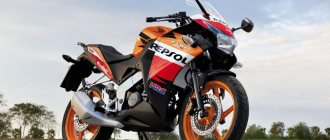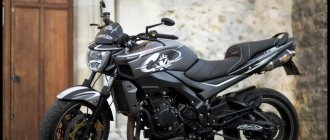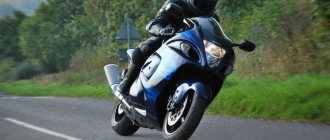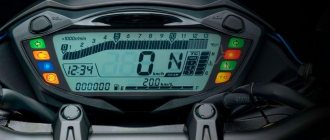| Suzuki GSX1300R Hayabusa (1999-2007)) | Suzuki GSX1300R Hayabusa (2008-2012) | Suzuki GSX1300R Hayabusa (2013-2015) |
| Suzuki GSX1300R Hayabusa (2016-2020) | Suzuki GSX1300R Hayabusa (2021+) |
Suzuki GSX1300R Hayabusa sports motorcycle model
was first introduced in 1999. This model was Suzuki's response to the fastest, at that time, production motorcycles from other Japanese manufacturers - the CBR1100xx Blackbird and Kawasaki ZZ-R1100. The technical characteristics and top speed of the Hayabusa surpassed its competitors and for a time made the model the fastest in the world with a speed record of 312 km/h. However, this speed could only exist on paper, since in the same year Japanese and European motorcycle manufacturers, fearing the introduction of restrictive bans on motorcycle sales, entered into an agreement according to which the maximum speed, regardless of engine power, could not exceed 299 km/h ( according to the speedometer). However, the Suzuki GSX1300R Hayabusa, even with this limitation, was considered a leader in the class for a long time.
Speaking about the class of such motorcycles, in those years the term “hyper-sport” was first used, the class of which included all similar models of motorcycles with record power and maximum speed. Suzuki classified the Hayabusa as an Ultimate Sport model.
In 2008, the Suzuki GSX1300R Hayabusa model underwent the first changes affecting the engine (increased displacement from 1299 to 1340 cm³, increased compression ratio from 11.0 to 12.5, increased power from 175 to 197 hp, titanium valves, lightweight pistons), system injection (double SDTV throttle valves - Suzuki Dual Throttle Valve), braking system (instead of 6-piston calipers - 4-piston radial Tokico; the rear brake disc was increased in diameter from 240 to 260 mm, the caliper was moved to the top of the disc), electronics (possibility of choosing from 3 power delivery modes - S-DMS system - Suzuki Drive Mode Selector), suspension (new fork coating, increased rigidity, steering damper with a remote reservoir), clutch (slipper), cooling system (curved radiator).
The next model change occurred in 2013. This year's models received an updated appearance and a new braking system (the diameter of the front discs was reduced from 320 to 310 mm, new Brembo radial monoblock calipers) with an optional ABS system.
In 2022, Suzuki introduced the new generation Hayabusa 2022 model year. The new model received an updated appearance, LED optics, a TFT display, an engine that complies with Euro 5 requirements, a new Brembo Stylema braking system and a whole set of electronic innovations:
- Electronic throttle (Ride-by-Wire system)
- Combined brakes with racing ABS Motion Track Anti-lock Brake System (MT-ABS)
- Cruise control
- Suzuki Intelligent Ride System (SIRS)
- Bi-directional Quick Shift system
- Suzuki Drive Mode Selector Alpha (SDMS-α)
- Anti-lift Control System (LF)
- Launch Control System (LC)
- Engine Brake Control System (EB)
- Suzuki Easy Start System
- Low RPM Assist System
- Motion Track Traction Control System (TC)
- Slope Dependent Control System
- Hill Hold Control System
- Hill Hold Control System
- Suzuki Ram Air-Direct (SRAD)
Since 2006 and the appearance of the Kawasaki ZZ-R 1400 model, Hayabusa has lost its leadership in this class, but this did not stop it from winning a huge army of admirers around the world and becoming a truly cult model.
In 2007, a naked model, the Suzuki B-King, was built on the basis of the Suzuki GSX1300R Hayabusa.
The main competitors of the Suzuki GSX1300R Hayabusa in the class:
- Kawasaki ZX-14R (ZZ-R1400) / Kawasaki ZX-12R
- Honda CBR1100xx
Brief history of the model
- 1999 - start of production and sales. First generation.
Model:
Suzuki GSX1300R Hayabusa (Europe, North America, Australia).
Factory designation
: GSX1300RX.
- 2000 - no significant changes.
Model:
Suzuki GSX1300R Hayabusa (Europe, North America, Australia).
Factory designation
: GSX1300RY.
- 2001 - no significant changes.
Model:
Suzuki GSX1300R Hayabusa (Europe, North America, Australia).
Factory designation
: GSX1300RK1.
- 2002 - no significant changes.
Model:
Suzuki GSX1300R Hayabusa (Europe, North America, Australia).
Factory designation
: GSX1300RK2.
- 2003 - no significant changes.
Model:
Suzuki GSX1300R Hayabusa (Europe, North America, Australia).
Factory designation
: GSX1300RK3.
- 2004 - no significant changes.
Model:
Suzuki GSX1300R Hayabusa (Europe, North America, Australia).
Factory designation
: GSX1300RK4.
- 2005 - no significant changes.
Model:
Suzuki GSX1300R Hayabusa (Europe, North America, Australia).
Factory designation
: GSX1300RK5.
- 2006 - no significant changes.
Model:
Suzuki GSX1300R Hayabusa (Europe, North America, Australia).
Factory designation
: GSX1300RK6.
- 2007 - no significant changes.
Model:
Suzuki GSX1300R Hayabusa (Europe, North America, Australia).
Factory designation
: GSX1300RK7.
- 2008 - restyling of the model. Second generation
.
Model:
Suzuki GSX1300R Hayabusa (Europe, North America, Australia).
Factory designation
: GSX1300RK8.
- 2009 - no significant changes.
Model:
Suzuki GSX1300R Hayabusa (Europe, North America, Australia).
Factory designation
: GSX1300RK9.
- 2010 - no significant changes.
Model:
Suzuki GSX1300R Hayabusa (Europe, North America, Australia).
Factory designation
: GSX1300RL0.
- 2011 - no significant changes.
Model:
Suzuki GSX1300R Hayabusa (Europe, North America, Australia).
Factory designation
: GSX1300RL1.
- 2012 - no significant changes.
Model:
Suzuki GSX1300R Hayabusa (Europe, North America, Australia).
Factory designation
: GSX1300RL2.
- 2013 - minor changes to the model.
Model:
Suzuki GSX1300R Hayabusa + ABS (Europe, North America, Australia).
Factory designation
: GSX1300RL3 + GSX1300RAL3.
- 2014 - no significant changes.
Model:
Suzuki GSX1300R Hayabusa + ABS (Europe, North America, Australia).
Factory designation
: GSX1300RL4 + GSX1300RAL4.
- 2015 - no significant changes.
Model:
Suzuki GSX1300R Hayabusa + ABS (Europe, North America, Australia).
Factory designation
: GSX1300RL5 + GSX1300RAL5.
- 2016 - no significant changes.
Model:
Suzuki GSX1300R Hayabusa + ABS (Europe, North America, Australia).
Factory designation
: GSX1300RL6 + GSX1300RAL6.
- 2017 - no significant changes.
Model:
Suzuki GSX1300R Hayabusa ABS (Europe, North America, Australia).
Factory designation
: GSX1300RAL7.
- 2018 - no significant changes.
Model:
Suzuki GSX1300R Hayabusa ABS (Europe, North America, Australia).
Factory designation
: GSX1300RAL8.
- 2019 - no significant changes.
Model:
Suzuki GSX1300R Hayabusa ABS (North America, Australia).
Factory designation
: GSX1300RAL9.
- 2020 - no significant changes.
Model:
Suzuki GSX1300R Hayabusa ABS (North America, Australia).
Factory designation
: GSX1300RAM0.
- 2021 (2022) - restyling of the model. Third generation
.
Model:
Suzuki GSX1300R Hayabusa (North America, Australia, Europe).
Factory designation
: GSX1300RRQM2.
Suzuki Hayabusa 2022 price
The new product is expected to arrive at dealers in mid-March (but not necessarily in the Russian Federation either), but the price for some markets has already been announced. In particular, for the British market it will be 16,499 pounds, and for the US $18,600, which is even slightly higher than that of its direct competitor - the supercharged 200-horsepower Kawasaki H2 SX, which costs 15,899 pounds in the UK. However, the better-equipped SE starts from £19,099. Of course, Suzuki only dreams of emptying the buyer's wallet completely, for which a catalog of factory accessories has been developed: a high windshield, a fairing for the passenger seat, tank bags, heated grips, milled levers, and a pair of slip-ons from Akrapovic.
The model is available in three color options - black with bronze accents, matte silver with red details and white with blue details. All variants shine with chrome accents around the side vents.
Specifications
Technical characteristics of Suzuki GSX1300R Hayabusa:
| Model | Suzuki GSX1300R Hayabusa |
| Motorcycle type | sports |
| Year of issue | 1999+ |
| Frame | aluminum |
| engine's type | 4-cylinder, 4-stroke, in-line |
| Working volume | 1299 cm³ – GSX1300R (1999-2007) 1340 cm³ – GSX1300R (2008+) |
| Bore/Stroke | 81.0 x 63.0 mm – GSX1300R (1999-2007) 81.0 x 65.0 mm – GSX1300R (2008+) |
| Compression ratio | 11.0:1 – GSX1300R (1999-2007) 12.5:1 – GSX1300R (2008+) |
| Cooling | liquid |
| Number of valves per cylinder | DOHC, 4 valves per cylinder |
| Fuel supply system | Injector, 4x – GSX1300R (1999-2007) Injector with SDTV (Suzuki Dual Throttle Valve), 4x – GSX1300R (2008+) |
| Ignition type | transistor |
| Maximum power | 175.0 hp (128.7 kW) at 9800 rpm - GSX1300R (1999-2007) 197.0 hp (145.0 kW) at 9500 rpm – GSX1300R (2008-2020) 190.0 hp (140.0 kW) at 9700 rpm – GSX1300R (2021+) S-DMS (Suzuki Drive Mode Selector) - 2008+ |
| Maximum torque | 138.0 Nm (14.1 kg*m) at 7000 rpm - GSX1300R (1999-2007) 155.0 Nm (15.8 kg*m) at 7200 rpm – GSX1300R (2008-2020) 150.0 Nm (15.2 kg*m) at 7000 rpm – GSX1300R (2021+) |
| Clutch | Multi-disc in oil bath, hydraulic drive |
| Transmission | 6-speed |
| type of drive | chain |
| Front tire size | 120/70-ZR17 (58W) |
| Rear tire size | 190/50-ZR17 (73W) |
| Front brakes | 2 discs, 320 mm, 6-piston calipers – GSX1300R (1999-2007) 2 discs, 320 mm, 4-piston radial calipers Tokico – GSX1300R (2008-2012) 2 discs, 310 mm, 4-piston radial monoblock Brembo calipers – GSX1300R (2013-2020), opt. ABS 2 discs, 320 mm, 4-piston Brembo Stylema radial calipers (combined, Motion-Track ABS) – GSX1300R (2021+) |
| Rear brakes | 1 disc, 240 mm, 1 piston caliper – GSX1300R (1999-2007) 1 disc, 260 mm, 1-piston caliper – GSX1300R (2008-2020), opt. ABS 2013+ 1 disc, 260 mm, 1-piston caliper (combined, Motion-Track ABS) – GSX1300R (2021+) |
| Front suspension | 43mm KYB inverted fork (fully adjustable), 120mm travel 43mm KYB inverted fork with DLC (diamond like carbon) (fully adjustable), 120mm travel – GSX1300R (2008+) |
| Rear suspension | pendulum with monoshock absorber (fully adjustable), stroke - 140 mm |
| Motorcycle length | 2140 mm – GSX1300R (1999-2007) 2190 mm – GSX1300R (2008-2020) 2180 mm – GSX1300R (2021+) |
| Motorcycle width | 740 mm – GSX1300R (1999-2007) 735 mm – GSX1300R (2008+) |
| Motorcycle height | 1155 mm – GSX1300R (1999-2007) 1165 mm – GSX1300R (2008+) |
| Wheelbase | 1485 mm – GSX1300R (1999-2007) 1480 mm – GSX1300R (2008+) |
| Seat height | 805 mm |
| Minimum ground clearance (clearance) | 120 mm 125 mm – GSX1300R (2021+) |
| Acceleration 0-100 km/h (0-60 mph) | 2.76 sec[1] |
| Maximum speed | 299 km/h (with limiter) |
| Gas tank capacity | 22.0 L – GSX1300R (1999-2007) 21.0 L – GSX1300R (2008-2020) 20.0L – GSX1300R (2021+) |
| Motorcycle weight (dry) | 215 kg – GSX1300R (1999-2007) 220 kg – GSX1300R (2008+) |
| Motorcycle weight (curb) | 266 kg – GSX1300R (2008-2020) 264 kg – GSX1300R (2021+) |
Description
The Suzuki GSX 1300R Hayabusa hyperbike model appeared in 1999 and continues to be produced to the present day. The main reason for the appearance of the motorcycle was Suzuki's desire to beat Honda with its CBR1100xx Blackbird and release the fastest production motorcycle. And they succeeded - for 6 years no one managed to catch up with the Suzuki GSX1300R Hayabusa. Only in 2005, with the release of the Kawasaki ZX-14R, the leadership among the most powerful mass-produced motorcycles passed to the Kawasaki company, but even this fact did not help reduce the popularity of the legendary Hayabusa. In the market of some countries, the model is called Suzuki Hayabusa.
By the way, even the release of the Kawasaki ZX-12R Ninja could not dislodge Hayabusa from the throne. Despite decent technical characteristics, the maximum speed achieved on the Kawasaki ZX-12R Ninja was 308 km/h, while the Suzuki GSX 1300R Hayabusa managed to accelerate to 312 km/h. In general, Kawasaki could have caught up with Suzuki at that moment (and even planned a large-scale presentation of the advantages of the ZX-12R over the Suzuki Hayabusa), but it was in 2000 that an agreement was signed between the Japanese manufacturers and BMW to limit the maximum possible speed to 299 km/h, which automatically made the Suzuki GSX1300R Hayabusa the fastest production motorcycle in the world until 2005, when the Kawasaki ZX-14R came out.
The main feature of the Suzuki GSX1300R Hayabusa is a specially developed in-line 4-cylinder liquid-cooled engine with a displacement of 1340 cc, producing 197 hp. power and 155 Nm of torque. The maximum speed is electronically limited to 299 km/h.
The model has an aluminum diagonal frame, sports adjustable suspension, powerful radial brakes, a fuel injection system with double flaps (proprietary SDTV system), a slipper clutch and a whole range of electronic systems (from ABS to engine power selection).
A naked model, the Suzuki B-King, was built on the basis of the Suzuki GSX1300R Hayabusa.
Reviews
Reviews of Suzuki GSX1300R Hayabusa:
Expand Collapse
First departure. This is not true, I was just afraid to accelerate. the first gas slightly and the axle boxes or wheel rises slightly. In short, while I was practicing starting and braking in different ways, I wiped out the tires and the pads. I still have only good memories about this mot. fifth speed, the speedometer needle is on the limiter (after 280 there are 2 more bars and a limiter) on the tachometer 10500, I turn it up to 11000, turn on 6 and the speed increase continues until 6 hits the cutoff of 11000 at 6... and it feels like you’re not driving on the road and you’re already floating. indescribable feelings. I only matured to the maximum speed after 2 seasons of ownership. I tried it a couple of times before, but by 280 I changed my mind.
Mot has never failed. I drove 10k miles on it. fuel consumption - city 10 suburban 5-12 (how to drive) average 8. Among the consumables, I changed the fork seals (learned to ride in the rear) 1 time, pads 2 times, rear tires 3 times, oil 3 times and oil filter 2 times.
The moto is very comfortable. up to 230 you don’t feel the wind pressure even with a passenger. Trips on the track showed that the brakes are not sporty at all and there is a lot of weight. decided to sell.
After the jixer, I smiled from the comfortable suspension and more torquey and flexible engine. On it you can drive 160 km/h in 6th gear and the engine will whisper at 5100 rpm, or you can quickly accelerate to 300 without shifting down. The only biggest drawback is the constant speeding - imaginable and inconceivable (once I deliberately rolled under camera at the entrance to a populated area 250 km/h) A small drawback is the weak front brakes. It’s difficult to ride Busa slowly, she really loves long straights and smooth high-speed turns, she’s cramped in the city. She doesn’t notice climbs, nor does a passenger up to 60 kg)))))) A very interesting motorcycle, but not for beginners. If you make friends with him, understand and feel him, there will be no equals on the track in 99% of cases, the main thing is without fanaticism, although he constantly provokes: I can do more than you and everyone around me. Overtaking at any speed without problems. I never had the feeling of “I’ll have time or I won’t have time.” I remember back in 1999 I read the Hayabusa test in Klaxon and got the impression that you had to be at least a hereditary cosmonaut, or at least a test pilot, to pilot Businka, but everything turned out to be simpler - if you don’t be rude to her, then everything will be fine and predictable.
In two months I covered a little over eight thousand km. The speedometer went down several times - it was a rocket! The road surface leaves much to be desired; you can't speed up! You can ride this starlet in different ways as your heart desires - smoothly and softly, or you can also make a grip on the rear wheel. The engine is “evil” when needed or, on the contrary, soft. The suspension is excellent, swallows almost everything within reasonable limits. This “monster” constantly provokes me to twist the gas slowly, it’s not interesting, the result was the second rear ramp and the front brake pads. Consumables are not a problem - you can get everything. Oil and fuel consumption is normal - how will you twist it!! In the city it is easy to steer. On the highway it's a song! Doesn't like weakness, requires good physical shape and attention on the road especially in the city - children, opening doors, deceptive turns and other unpredictable “frames” in general, I really like the mot and all my friends - cool technique - a clot of adrenaline!!!!!!
Suzuki Hayabusa 2022 chassis
But it’s not just the engine that remains recognizable: the 2022 chassis is also basically the same as the previous version. Is this bad? It’s unlikely, because the Hayabusa has always been considered almost a model of handling in its class, and now, when the Busa will receive the suspension of the 2022 version and an updated chassis, there was no reason to change the legendary two-spar frame.
Suzuki Hayabusa 2022









